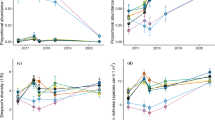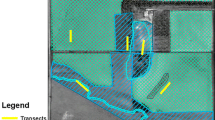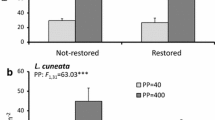Abstract
Restoring prairie on formerly cultivated land begins by selecting propagule seed sources and the diversity of species to reintroduce. This study examined the effects of dominant grass propagule source (cultivar vs. non-cultivar) and sown propagule diversity (grass:forb sowing ratio) on plant community structure. Two field experiments were established in Kansas and Illinois consisting of identical split plot designs. Dominant grass source was assigned as the whole-plot factor, and sown dominance of grasses (five levels of seeded grass dominance) as the subplot factor. Species density, cover, and diversity were quantified for 5 years. The effect of dominant grass source on the cover of focal grasses, sown species, and volunteer species was contingent upon location, with variation between dominant grass sources observed exclusively in Kansas. Species density and diversity showed regionally convergent patterns in response to dominant grass source. Contrary to our hypotheses, total species density and diversity were not lower in the presence of grass cultivars, the grass source we had predicted would be more competitive. Sown grass dominance effects on the cover of the focal grass species were contingent upon location resulting from establishment corresponding better to the assigned treatments in Illinois. All other cover groups showed regionally convergent patterns, with lower cover of volunteers and higher cover of sown forbs, diversity, and species density in the lowest sown grass dominance treatment in both sites. Thus, decisions regarding the diversity of propagules to reintroduce had more consequence for plant community structure than cultivar or non-cultivar source of dominant grasses.






Similar content being viewed by others
References
Baer SG, Gibson DJ, Benscoter AM, Reed LK, Campbell RE, Klopf RP, Willand JE, Wodika BR. (2013) No effect of seed source on multiple aspects of ecosystem functioning during ecological restoration: cultivars compared to local ecotypes of dominant grasses. Evol Appl. doi:10.1111/eva.12124
Baer SG, Blair JM, Collins SL, Knapp AK (2004) Plant community responses to resource availability and heterogeneity during restoration. Oecologia 139:617–629
Betz RF (1986) One decade of research in prairie restoration at the Fermi National Accelerator Laboratory (Fermilab), Batavia, Illinois. In Clambey GK and Pemble RH (eds) The prairie: past, present, and future. Proceedings of Ninth North American Prairie Conference, Moorhead State University, Morehead, MN. Tri-College University Center for Environmental Studies, Fargo, North Dakota, pp 179–185
Blumenthal DM, Jordan NR, Russelle MP (2003) Soil carbon addition controls weeds and facilitates prairie restoration. Ecol Appl 13:605–615
Bradford MA, Wood SA, Maestre FT, Reynolds JF, Warren RJ II (2012) Contingency in ecosystem but not plant community response to multiple global change factors. N Phytol 196:462–471
Bradshaw AD (1965) Evolutionary significance of phenotypic plasticity in plants. Adv Genet 13:115–156
Bradshaw AD (1987) Restoration: an acid test for ecology. In: Jordan W, Gilpin M, Aber J (eds) Restoration ecology: a synthetic approach to ecological research. Cambridge University Press, Cambridge, pp 23–30
Broadhurst LM, Lowe A, Coates DJ, Cunningham SA, McDonald M, Vesk PA, Yates C (2008) Seed supply for broadscale restoration: maximizing evolutionary potential. Evol Appl 1:587–597
Carter DL, Blair JM (2012a) Recovery of native plant community characteristics on a chronosequence of restored prairies seeded into pastures in west-central Iowa. Restor Ecol 20:170–179
Carter DL, Blair JM (2012b) High richness and dense seeding enhance grassland restoration establishment, but have little effect on drought response. Ecol Appl 22:1308–1319
Clausen J and Hiesey WM (1958) Experimental studies on the nature of species. IV. Genetic structure of ecological races. Publication #615, Carnegie Institution of Washington, Washington, DC
Cottam G (1987) Community dynamics on an artificial prairie. In: Jordan WR III, Gilpin ME, Aber JD (eds) Restoration ecology: a synthetic approach to ecological research. Cambridge University Press, Cambridge, pp 257–270
Dickson TL, Busby WH (2009) Forb species establishment increases with decreased grass seeding density and with increased forb seeding density in a Northeast Kansas, USA, experimental prairie restoration. Restor Ecol 17:597–605
Doherty JM, Callaway JC, Zedler JB (2011) Diversity-function relationships changed in a long-term restoration experiment. Ecol Appl 21:2143–2155
Dyer AR, Rice KJ (1997) Evidence of spatial genetic structure in a California bunchgrass population. Oecologia 112:333–339
Erickson B, Navarrete-Tindall NE (2004) Missouri native ecotype program: increasing local-source native seed. Nat Areas J 24:15–22
Falk DA (1990) Integrated strategies for conserving plant genetic diversity. Ann Mo Bot Gard 77:38–47
Fattorini M, Halle S (2004) The dynamic environmental filter model: how do filtering effects change in assembling communities after disturbance? In: Temperton VM, Hobbs RJ, Nuttle T, Halle S (eds) Assembly rules and restoration ecology. Island Press, Washington, pp 96–114
Fehr WR (1987) Principles of cultivar development: theory and technique. Macmillan Publishing Company, New York
Freeman CC (1998) The flora of Konza Prairie: a historical review and contemporary patterns. In: Knapp AK, Briggs JM, Hartnett DC, Collins SL (eds) Grassland dynamics: long-term ecological research in tallgrass prairie. Oxford Press, New York, pp 69–80
Gibson DJ, Allstadt AJ, Baer SG, Geisler M (2012) Effects of foundation species genotypic diversity on subordinate species richness in an assembling community. Oikos 121:496–507
Gibson DJ, Baer SG, Klopf RP, Reed LK, Wodika BR, Willand JE (2013) Limited effects of dominant species population source on community composition during community assembly. J Veg Sci 24:429–440
Gordon DR, Rice KJ (1998) Patterns of differentiation in wiregrass (Aristida beyrichiana): implications for restoration efforts. Restor Ecol 6:166–174
Gustafson DJ, Gibson DJ, Nickrent DL (2004) Conservation genetics of two co-dominant grass species in an endangered grassland ecosystem. J Appl Ecol 41:389–397
Hansen MJ and Gibson DJ (2013) Use of multiple criteria in an ecological assessment of a prairie restoration chronosequence. Appl Veg Sci, in press doi:10.1111/avsc.12051
Harris JA, Hobbs RJ, Higgs E, Aronson J (2006) Ecological restoration and global climate change. Restor Ecol 14:170–176
Hayden BP (1998) Regional climate and the distribution of tallgrass prairie. In: Knapp AK, Briggs JM, Hartnett DC, Collins SL (eds) Grassland dynamics: long-term ecological research in tallgrass prairie. Oxford Press, New York, pp 19–34
Hilderbrand RH, Watts AC, Randle AM (2005) The myths of restoration ecology. Ecol Soc 10:19
Hobbs RJ, Norton DA (1996) Towards a conceptual framework for restoration ecology. Restor Ecol 4:93–110
Hobbs RJ, Norton DA (2004) Ecological filters, thresholds, and gradients in resistance to ecosystem reassembly. In: Temperton VM, Hobbs RJ, Nuttle T, Halle S (eds) Assembly rules and restoration ecology. Island Press, Washington, pp 72–95
Hufford KM, Mazer SJ (2003) Plant ecotypes: genetic differentiation in the age of ecological restoration. Trends Ecol Evol 18:147–155
Huxman TE, Smith MD, Fay PA et al (2004) Convergence across biomes to a common rain-use efficiency. Science 429:651–654
Jackson ST, Hobbs RJ (2009) Ecological restoration in the light of ecological history. Science 325:567–569
Keddy PA (1992) Assembly response and rules—2 goals for predictive community ecology. J Veg Sci 3:157–164
Keller M, Kollman J, Edwards PJ (2000) Genetic introgression from distant provenances reduces fitness in local weed populations. J Appl Ecol 37:647–659
Kindscher K, Frazer A (2000) Planting forbs first provides greater species diversity in tallgrass prairie restorations (Kansas). Ecol Restor 18:115–116
Klopf RK, Baer SG (2011) Root dynamics of cultivar and non-cultivar population sources of two dominant grasses during initial establishment of tallgrass prairie. Restor Ecol 19:112–117
Lambert AM, Baer SG, Gibson DJ (2011) Intraspecific variation in ecophysiology of three dominant prairie grasses used in restoration: cultivar versus non-cultivar population sources. Restor Ecol 19:43–52
Laurenroth WK, Burke IC, Gutmann MP (1999) The structure and function of ecosystems in the central North American grassland region. Gt Plains Res 9:223–259
Lawton JH (1999) Are there general laws in ecology? Oikos 84:177–192
Lesica P, Allendorf FW (1999) Ecological genetics and the restoration of plant communities: mix or match? Restor Ecol 7:42–50
Littell RC, Milliken GA, Stroup WW, Wolfinger RD, Schabenberger O (2006) SAS for mixed models, 2nd edn. SAS Institute Inc., Cary
MacDougall AS, Wilson SD, Bakker JD (2008) Climatic variability alters the outcome of long-term community assembly. J Ecol 96:346–354
Manning R (1995) Grassland: the history, biology, politics, and promise of the American Prairie. Penguin Books, New York
McCain KNS, Baer SG, Blair JM, Wilson GWT (2010) Dominant grasses suppress local diversity in restored tallgrass prairie. Restor Ecol 18:40–49
McKay JK, Christian CE, Harrison S, Rice KJ (2005) “How local is local?—a review of practical and conceptual issues in the genetics of restoration. Restor Ecol 13:432–440
Milliken, GA and Johnson DE (1992) Analysis of messy data. Vol 1: designed experiments. Chapman & Hall, London
Montalvo AM, Williams SL, Rice KJ, Buchmann SL, Cory C, Handel SN, Nabhan GP, Primack R, Robichaux RH (1997) Restoration biology: a population biology perspective. Restor Ecol 5:277–290
National Oceanic and Atmospheric Administration. National Climatic Data Center. Asheville, NC, USA. http://www.ncdc.noaa.gov/. Accessed 21 Oct 2012
Paradeis BL, DeKeyser ES, Kirby DR (2010) Evaluation of restored and native pothole region plant communities following an environmental gradient. Nat Areas J 30:294–304
Piper JK, Schmidt ES, Janzen AJ (2007) Effects of species richness on resident and target species components in a prairie restoration. Restor Ecol 15:189–198
Polley HW, Derner JD, Wilsey BJ (2005) Patterns of plant species diversity in remnant and restored tallgrass prairies. Restor Ecol 13:480–487
Rice KJ, Emery NC (2003) Managing microevolution: restoration in the face of global change. Front Ecol Environ 1:469–478
Rowe HI (2010) Tricks of the trade: techniques and opinions from 38 experts in tallgrass prairie restoration. Restor Ecol 18:253–262
Samson FB, Knopf FL, Ostlie WR (2004) Great plains ecosystems: past, present, and future. Wildl Soc Bull 32:6–15
Skeel VA, Gibson DJ (1996) Physiological performance of Andropogon gerardii, Panicum virgatum, and Sorghastrum nutans on reclaimed mine spoil. Restor Ecol 4:355–367
Sluis WJ (2002) Patterns of species richness and composition in re-created grassland. Restor Ecol 10:677–684
Smith MD, Wilcox JC, Kelly T, Knapp AK (2004) Dominance not richness determines invasibility of tallgrass prairie. Oikos 106:253–262
Taft JB, Hauser C, Robertson KR (2006) Estimating floristic integrity in tallgrass prairie. Biol Conserv 131:42–51
Templeton AR (1986) Coadaptation and outbreeding depression. In: Soule M (ed) Conservation biology: the science of scarcity and diversity. Sinauer Associates Inc., Sunderland, pp 105–116
United States Department of Agriculture (USDA) (1995) Grass varieties in the United States. CRC Press, Boca Raton
Weber S (1999) Designing seed mixes for prairie restorations: revisiting the formula. Ecol Restor 17:196–201
Wilsey BJ (2010) Productivity and subordinate species response to dominant grass species and seed source during restoration. Restor Ecol 18:628–637
Acknowledgments
Field and laboratory assistance were provided by Elizabeth Bach, Ryan Campbell, Rachel Goad, Allison Lambert, Lewis Reed, Jason Willand, Ben Wodika, Bryan Young, staff at both the Konza Prairie Biological Station and the Southern Illinois University Carbondale Belleville Center, and many undergraduate students. This research was funded by the Konza Prairie Long Term Ecological Research program and the National Science Foundation (DEB 0516429).
Author information
Authors and Affiliations
Corresponding author
Electronic supplementary material
Below is the link to the electronic supplementary material.
Rights and permissions
About this article
Cite this article
Klopf, R.P., Baer, S.G. & Gibson, D.J. Convergent and Contingent Community Responses to Grass Source and Dominance During Prairie Restoration Across a Longitudinal Gradient. Environmental Management 53, 252–265 (2014). https://doi.org/10.1007/s00267-013-0209-3
Received:
Accepted:
Published:
Issue Date:
DOI: https://doi.org/10.1007/s00267-013-0209-3




